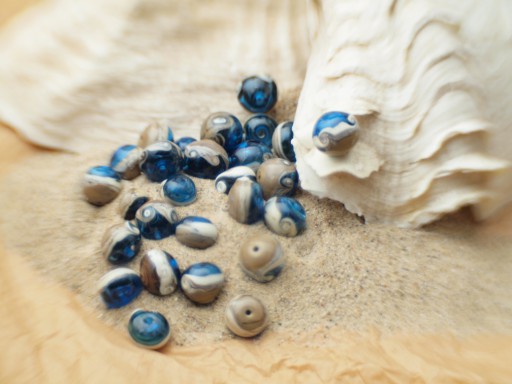The August (or July...I can't keep these things straight) bead challenge was on a beach theme, to go with the summer picnic being held at Cyndy G's poolside. Parameters were to use transparent blues and greens (esp aqua) to represent water, sand, tan and the like to represent the seashore, and ivory and silvered ivory stringer (and twisting) for waves. Oh, and opaque orangey-yellow for fish, if desired.

beach challenge beads. Week ending July 13, 2013. Effetre aqua, sage, ivory (mostly) and silvered ivory stringer. Hollow, approximately 10mm hole to hole.
I've never worked with silvered ivory stringer, so I did a little research. Traditionally, you wrap a warm rod of (dark) ivory in silver leaf or sheet, burn (i.e. dissolve) it into the glass, pull it into a stringer and voila. The appeal, so far as I can tell, is the rather organic webbing that results.
Silvered ivory stringers have a rep for being brittle, and I was kind of intrigued by one woman's demo in which she cased the ivory around clear. This, I thought, would probably reduce the brittleness, and possibly add some interesting viscosity effects (to mention saving a little money and using up bad clear. I am all about using up bad glass.) I also liked the idea of using only partial coverage. This is a nice, thorough tutorial, and I didn't work at nearly as meticulously as she documented—slopped on ivory over a rod, rolled perhaps a third of a torn sheet of silver leaf (not foil) and pulled into a long stringer about 1.5-2mm thick.
I discovered I like my ivory stringer with sparse silver. Also, I do think the clear core made the stringer less brittle—I had no trouble working with my usual lengths (up to 24" or so). What bugged me the most about these beads is that whether I put the silvered ivory or regular ivory on first, with any kind of heating, the silvered ivory went all over the place, covering up the plain ivory that I wanted to represent the crest of my waves.
To back p a bit, the beads were made with some sort of odd lot aqua (that looks pretty much like standard aqua, as you can see) and sage halves. Then I would ‘seal’ the halves together with ivory stringer, draw on some silvered ivory stringer, melt the thing into approximate (very approximate—these were terribly badly made beads) roundness, and finally twist either 5 or 1 times for the final result.
I wanted that white along the top. Of course, aqua reacts with ivory, so on a couple of beads I tried putting on a ‘barrier’ of clear, but it didn't really seem to help.
Overall, probably the most fun I had with these beads was photographing them, using some shells, sand and tan colored tissue paper, along with lensbaby. Of course, the picture came out much better in my head than on the screen, but I do think it gives these mediocre[1] beads decent visual interest.
[1]Granted the design is not thrilling; but what really annoys me is the lousy technique. With decent shaping these could be quite nice.
Unless otherwise noted, text, image and objects depicted therein copyright 1996--present sylvus tarn.
Sylvus Tarn